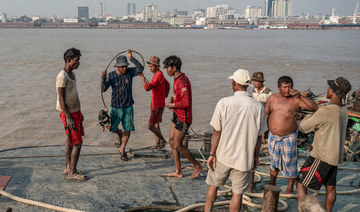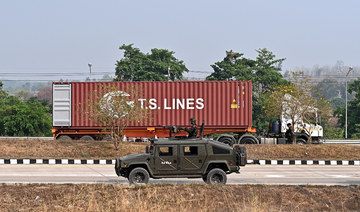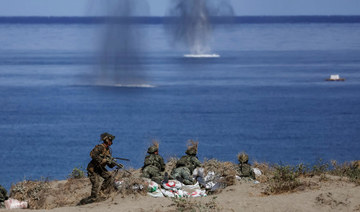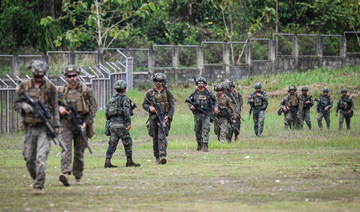FRANKFURT: Thousands of residents in German city Frankfurt were free to return to their homes Sunday afternoon after authorities reported that an unexploded World War II bomb found close to the European Central Bank headquarters had been defused.
"We did it! The World War II bomb in the Ostend neighbourhood has been defused by the ordnance disposal team. Roadblocks and evacuation zones have been lifted," the city fire service tweeted.
As well as the massive glass-shelled ECB skyscraper, residential areas home to some 16,000 people within a roughly one-kilometre (0.6-mile) radius of the 500-kilogramme (1,100 pound) bomb were evacuated.
Police combed the area early in the morning for stay-behinds, after loudspeaker trucks circulated urging the inhabitants to leave.
"It's actually nice to meet the people of the area, because when you live in apartments you don't always know everybody," evacuee Carmel McKiernan told AFP at a welcome centre set up in the Frankfurt zoo, where many older and less mobile people were sheltering from the rain.
"It was well organised, I think, even if these loud announcements in the streets were a bit militaristic," said fellow evacuee Andreas Mueller.
"We're going to go for a nice walk with the kids, go to the park, thank God it's not too hot today," said William, 35, outside a nearby cafe with his family.
The US fragmentation bomb with two detonators was found on June 25 during construction work in the centre of Germany's banking capital.
The ordnance clearance service determined that it posed no immediate danger and scheduled the operation to defuse it on Sunday.
The evacuation zone stretched across both banks of the Main river, forcing the suspension of several train services on top of the general lockdown.
Authorities were keen to avoid delays that marred an even bigger evacuation in September 2017 when 60,000 people had to leave their homes, hotel rooms and hospital wards following the discovery of a monster bomb filled with 1.4 tonnes of explosives.
This time around, all those affected were given free entry for the day to the city's museums -- a courtesy also to be extended to the emergency personnel who received vouchers to visit on other days.
Nearly 75 years after the end of the Second World War, Germany is still littered with bombs and other unexploded ordnance.
Experts say at least 10 percent of the millions of bombs dropped on Germany during the conflict did not explode.
A week ago a buried bomb exploded in a field in western Germany, leaving a huge crater but causing no injuries.
And earlier this month, a 100-kilogramme US bomb was defused near Alexanderplatz in central Berlin after the evacuation of around 3,000 people.
Around 2,000 dud bombs are believed to remain buried in Frankfurt, which was heavily bombed by American and British forces in the last years of the war.
Frankfurt prepares to defuse WWII bomb, thousands evacuated
Frankfurt prepares to defuse WWII bomb, thousands evacuated

- City officials called on some 16,500 people to leave their homes in the Ostend area Sunday morning
- Unexploded bombs are frequently found in Germany and disposing of them sometimes requires large-scale precautionary evacuations
AstraZeneca says withdraws Covid vaccine ‘for commercial reasons’

LONDON: British drugmaker AstraZeneca said Wednesday that it has withdrawn its Covid vaccine Vaxzevria, one of the first produced in the pandemic, citing “commercial reasons” and a surplus of updated jabs.
“As multiple, variant Covid-19 vaccines have since been developed there is a surplus of available updated vaccines. This has led to a decline in demand for Vaxzevria, which is no longer being manufactured or supplied,” an AstraZeneca spokeperson said.
3 Indian men charged with killing Sikh separatist leader in Canada appear in court

SURREY, British Columbia: Three Indian men charged with killing Sikh separatist leader Hardeep Singh Nijjar in British Columbia last year have appeared in court in the case that set off a diplomatic spat after Canadian Prime Minister Justin Trudeau said there were “credible allegations” of Indian involvement.
Canadian police had arrested the three Indian men last week in Edmonton, Alberta, and they have been charged with first-degree murder and conspiracy to commit murder.
Canadian Mounted Police Superintendent Mandeep Mooker said Friday that the investigation into whether the men had ties to India’s government was ongoing.
Nijjar, 45, was shot to death in his pickup truck last June after he left the Sikh temple he led in the city of Surrey. An Indian-born citizen of Canada, he owned a plumbing business and was a leader in what remains of a once-strong movement to create an independent Sikh homeland. India designated him a terrorist in 2020 and at the time of his death had been seeking his arrest for alleged involvement in an attack on a Hindu priest.
India has denied involvement in the slaying. In response to the allegations, India told Canada last year to remove 41 of its 62 diplomats in the country. Tensions remain but have somewhat eased since.
The arrested men — Kamalpreet Singh, 22, Karan Brar, 22, and Karanpreet Singh, 28 — appeared in court Tuesday via a video link and agreed to a trial in English. They were ordered to appear in British Columbia Provincial Court again on May 21.
Brar and Karanpreet Singh appeared in the morning. Kamalpreet’s appearance was delayed until the afternoon as he waited to speak to a lawyer.
The small provincial courtroom was filled with spectators during the morning session. Others crowded into an overflow room to watch the proceedings via video.
Richard Fowler, the defense lawyer representing Brar, said the case will eventually be moved to the Supreme Court and combined into one case.
About 100 people gathered outside the courthouse waving yellow flags and holding photos of Indian government officials whom they accuse of being involved in Nijjar’s killing.
Canadian police say the three suspects had been living in Canada as non-permanent residents.
A bloody decadelong Sikh insurgency shook north India in the 1970s and 1980s until it was crushed in a government crackdown in which thousands of people were killed, including prominent Sikh leaders.
The Khalistan homeland movement has lost much of its political power but still has supporters in the Indian state of Punjab, as well as in the sizable overseas Sikh diaspora. While the active insurgency ended years ago, the Indian government has repeatedly warned that Sikh separatists were trying to make a comeback.
UN: Myanmar displaced now at 3 million
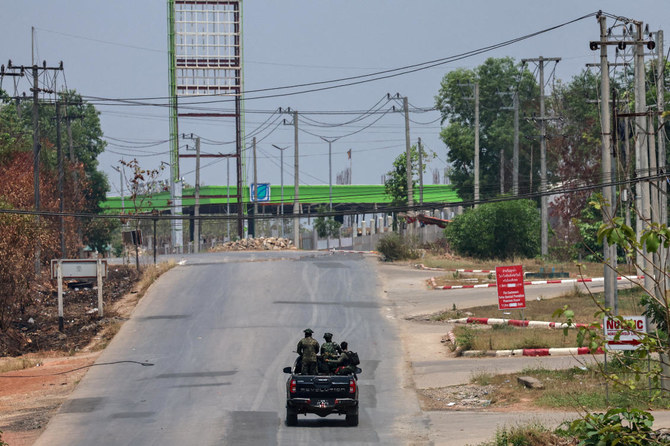
- An estimated one-third of those displaced are children, according to the UN statement
YANGON: The number of displaced people in Myanmar has reached three million, the United Nations said, the vast majority forced to flee their homes by conflict unleashed by the military’s 2021 coup.
Around 2.7 million have fled since the putsch that toppled Aung San Suu Kyi’s government after a short-lived experiment with democracy.
The coup sparked renewed clashes with established ethnic armed groups and birthed dozens of new “People’s Defense Forces” that the military has failed to crush.
“Myanmar stands at the precipice in 2024 with a deepening humanitarian crisis,” the UN’s resident coordinator in the country said in a statement released on Monday.
An estimated one-third of those displaced are children, according to the statement.
Around half of the three million have been displaced since late last year, when an alliance of ethnic armed groups launched an offensive across northern Shan state, the statement said.
The offensive seized swathes of territory and lucrative trade crossings on the China border, posing the biggest threat to the junta since it seized power.
Myanmar’s borderlands are home to a plethora of ethnic armed groups, many of whom have battled the military since independence from Britain in 1948 over autonomy and control of lucrative resources.
The UN said a severe funding shortfall was hampering its relief efforts, particularly ahead of the May-June cyclone season.
Last year cyclone Mocha smashed into western Myanmar’s Rakhine state, killing at least 148 people.
More than 355,000 people are currently displaced in western Rakhine state, which has been rocked since November by clashes between the Arakan Army and the military, the UN said.
Russian court says US soldier charged with theft causing ‘significant’ damage

- Detention of Gordon Black presents yet another diplomatic headache for the US
- The US soldier was detained in early May in Vladivostok, in Russia’s Far East
MOSCOW: US soldier Gordon Black, who has been detained the Russian city of Vladivostok until July 2, has been charged with theft causing significant damage, a Russian court said.
The detention of Black, who the Pentagon said traveled to Russia without authorization, presents yet another diplomatic headache for the United States, which has warned US citizens against all travel to Russia.
He was detained in early May in Vladivostok, in Russia’s Far East.
The Pervomaisky District Court of Vladivostok said in a statement that it had decided on the preventive measure to detain Black until July 2 for “secretly stealing the property of citizen T., causing the latter significant damage.”
“When choosing the preventive measure in the form of detention, the court came to the conclusion that US citizen B. (Black) — under the weight of the charges — could hide from the preliminary investigation authorities and the court to avoid responsibility,” the court said in the statement.
Earlier, the court’s press service identified the soldier as Gordon Black.
The Russian interior ministry in Vladivostok said on Tuesday that a 32-year-old woman had filed a complaint against the 34-year-old suspect.
The two had met in South Korea. The American had come to Vladivostok to visit her, the two had an argument, and she later filed a police report accusing him of stealing money, it said. He was arrested in a local hotel, having bought a plane ticket to return home.
The Pentagon said on Tuesday that before his arrest in Russia, Black not only broke Army rules by traveling to the Russian city of Vladivostok without authorization, but he did so after passing through China.
US, Philippine and Australian forces sink a ship during war drills in the disputed South China Sea
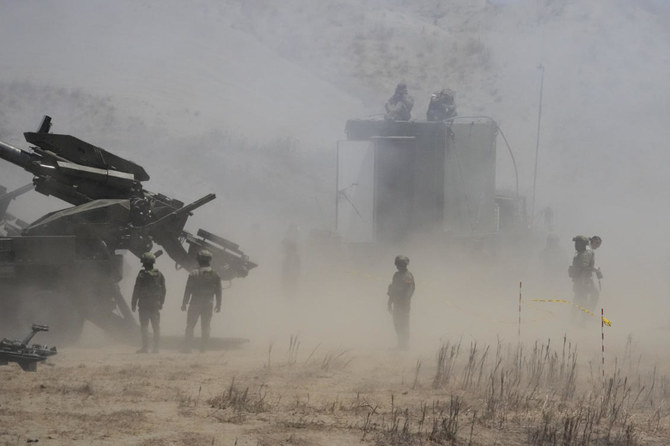
- Philippine President Ferdinand Marcos Jr.has ordered his military to shift its focus to external defense from decades-long domestic anti-insurgency operations
LAOAG, Philippines: Military force from the United States, Australian and the Philippines launched a barrage of high-precision rockets, artillery fire and airstrikes to sink a ship Wednesday as part of largescale war drills in waters facing the disputed South China Sea that have antagonized Beijing.
Military officials and diplomats from several countries, along with journalists, watched the display of firepower from a hilltop along a sandy coast in Laoag City on Wednesday in Ilocos Norte, Philippine President Ferdinand Marcos Jr.’s northern home province.
More than 16,000 military personnel from the United States and the Philippines, backed by a few hundred Australian troops and military observers from 14 countries were participating in annual combat-readiness drills called Balikatan, Tagalog for shoulder-to-shoulder, which started on April 22 and will end on Friday.
It’s the latest indication of how the United States and the Philippines have bolstered a defense treaty alliance that started in the 1950s.
Marcos has ordered his military to shift its focus to external defense from decades-long domestic anti-insurgency operations as China’s increasingly aggressive actions in the South China Sea become a top concern. That strategic shift dovetails with the efforts of President Joe Biden and his administration to reinforce an arc of alliances in the Indo-Pacific region to counter China.
China has angered the Philippines by repeatedly harassing its navy and coast guard ships with the use of powerful water cannons, a military-grade laser, blocking movements and other dangerous maneuvers in the high seas near two disputed South China Sea shoals that have led to minor collisions. Those have caused several injuries to Filipino navy personnel and damaged supply boats.
“We’re under the gun,” Philippine ambassador to Washington Jose Romualdez told The Associated Press in a telephone interview.
“We don’t have the wherewithal to be able to fight all of this bullying coming from China so where else will we go?” Romualdez asked. “We went to the right party which is the United States and those that believe in what the US is doing.”
China has accused the Philippines of setting off the hostilities in the disputed waters by encroaching into what it says are its offshore territories, demarcated by 10 dashes on a map. This has often prompted the Chinese coast guard and navy to take steps to expel Philippine coast guard and other vessels from that area. The Philippines, backed by the US and its allies and security partners, has repeatedly cited a 2016 international arbitration ruling based on the United Nations Convention of the Law of the Sea that invalidated China’s claim over virtually the entire South China Sea on historical grounds.
China did not participate in the arbitration complaint filed by the Philippines in 2013, rejected the ruling, and continues to defy it.
After an hour of the combat-readiness drills, black smoke started to billow from the stern of the mock enemy ship that was struck by missile fire and it started to sink ,as shown on a monitor watched by foreign military guests and journalists. US and Philippine warplanes later dropped bombs on the BRP Lake Caliraya, the target ship, which was made in China but decommissioned by the Philippine navy in 2020 due to mechanical and electrical issues, according to Philippine military officials.
Philippine military officials said the maneuvers would bolster the country’s coastal defense and disaster-response capabilities and claimed they were not aimed at any country. China has opposed military drills involving US forces in the region as well as increasing US military deployments, which it warned would ratchet up tensions and hamper regional stability and peace.
Washington and Beijing have been on a collision course over China’s increasingly assertive actions to defend its vast territorial claims in the South China Sea, and Beijing’s stated goal of annexing Taiwan, by force if necessary.
In February last year, Marcos approved a wider US military presence in the Philippines by allowing rotating groups of American military forces to stay in four more Philippine military camps. That was a sharp turnaround from his predecessor Rodrigo Duterte, who feared that a larger American military footprint could antagonize Beijing.
China strongly opposed the move, which would allow US forces to establish staging grounds and surveillance posts in the northern Philippines across the sea from Taiwan, and in western Philippine provinces facing the South China Sea.
China has warned that a deepening security alliance between Washington and Manila and their ongoing military drills should not harm its security and territorial interests or interfere in the territorial disputes. The Philippines countered that it has the right to defend its sovereignty and territorial interests.
“An alliance is very important to show China that you may have all the ships that you have, but we have a lot of firepower to sink all of them,” Romualdez said.









